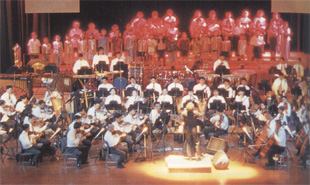|
|
|
The Arts
|
Performance by the Bangkok Symphony Orchestra
Many musicians who had the
opportunity to further their studies
abroad have come back wilh refined
skills and increased knowledge and have
passed on this precious treasure to their
students, both by teaching in schools
and by operating their private studios.
Noted teachers in this category are for
and the Ministry of University Affairs
in terms of curriculum content. Western
music classes, both practical and
theorytical have heen integrated into
the school curriculum in Thailand
in these past three decades in every
elementary school, high school and
college level. Western music classes
become compulsory classes for some
and elective classes for others. Students
have an opportunity to, for example,
taki: music appreciation class, learn
how to play a recorder, learn how to sing,
and participate in the school's chorus.
marching band, and orchestra.

Performance, by the Bangkok symphony orchestra
|
There has been a huge development in music education at the higher
education level. Government organizations and universities have opened
music schools and music faculties
starting with the School of Fine Arts
which belongs to the Fine Arts Department (opened in 1934), followed by
Chulalongkorn University, Payap University,
Srinakarinwiroj Prasarnmit University,
Kasetsart University,
Mahidol University, Silapakorn University, Khon Kaen University, etc.
At the undergraduate level, there
are mainly two different areas of study:
pure music (music performance) and
music education. The aim of the pure
music programme is to produce musicians.Thc aim of music education is to
produce music teachers and music educators.
For the graduate level, there
are programmes on musicology, music
education, ethnomusicology (cultural
studies emphasizing Thai or eastern
music) and recently a programme on
performance. Mahidol University is
planningtoopenaprogrammein music
therapy, music industry and music
technology in 2001.
Besides the serious music education
in schools and colleges, privately owned
music institutes, music organizations,
non-degree music programmes and
music-related companies are growing
rapidly to serve the demand of the
music market in Thailand. This is especially true in the past decade. Some of
the early established inslilutes continue
their tradition while others expand and
provide more functions to the genera!
public. These institutes are, for example,
Yamaha School of Music (Siam
Kolakarn), Robinson School Music,
Nat's Studio, Music Campus tor
General Public (MCGP) of Mahidol
University, Bangkok String Training
Institute (BST) of me Bangkok Symphony Orchestra. Chimakarn Music
School, MIFA International Academy of
Music of Grammy, Dr. Sax Music
School, D&M Music Studio and so on,
in addition to giving music instruction
many of these institutes sell musical
instruments and music scores, organize
music examinations, promote and
organize concerts and ompetitions,
seminars, workshops, and music camps.
In addition to music institutes,
many music societies and foundations
also provide support, sponsorship and
organize music activities, for example,
the Bangkok Symphony Orchestra
Foundation, Piyabhand Sanitwongse
Foundation, the Bangkok Chopin.
His Majesty in a jam session with the
reknown of jazz musician Benny Goodinun
Society and the Bangkok Music Society.
Musicians from all over the world
are interested in coming to Thailand for
musical opportunities. Professional
concert organizing is another music
business being seen in recent years.
Concert halls become a necessity for all
musical performances and activities,
New places are being built and old
places are renovated.
As in classical music, jazz music
in Thailand owes much to Phra Chen
Duriyang. Although be himself was not
a jazz musician, he did lay a solid
foundation of music for this students.
His students were the first group of
jazz musicians in Thailand, In 1925.
Luang Sukhum Naipradit came back
from Boston and brought some music
with him; he started to play jazz with
his ownjaz? band. While in Boston, he
studied jazz via playing tenor saxophone
and banjo. From 1934, his band received
much recognition. Around the time
Luang Sukhum Naipradil was
leading his jazz. band. Captain
Marut Senaweenin founded a jazz
group called "Manit Jazz". Increasingly. all band members were female.
In 1946, His Majesty King
Bhumibol Adulyadej composed his
first song called Candlelight Blues,
a 24-bar blues. Since then, His
Majesty has composed a total of 47
songs. He is truly a versatile com-
poser who has pioneered modern jazz
composition in Thailand. Today, the
King Bhumihol College of Music,
Mahidol University is the very first
college of music in Thailand lo offer a
degree majoring in jazz. studies.
The rapid growth and development
mentioned above reflect the Thai people's
increasing interest and appreciation of
Western music. This is a good sign
because a country can be considered as
civilized not only because it advances
materialistic ally but culiurally also. As
His Majesty said:
"....music is a part of me. It is a
part of everyone, an essential part of
us all. To me, music is something fine
and beautiful. I think we should all
recognize the value of music in all its forms."
| | |
|
|